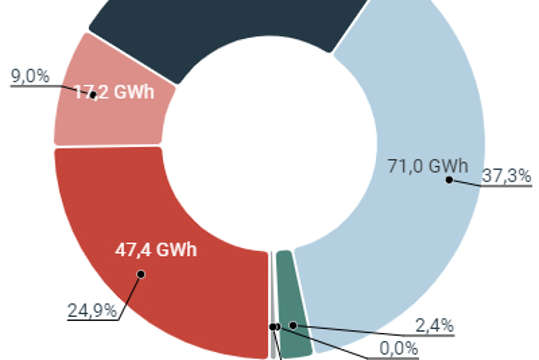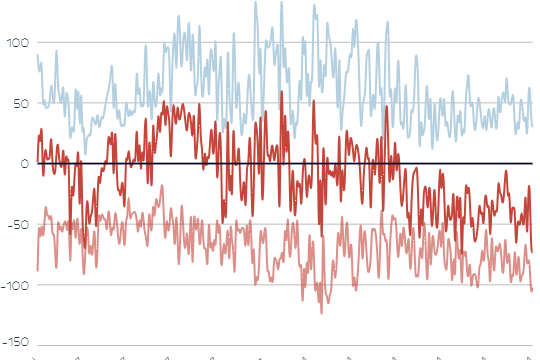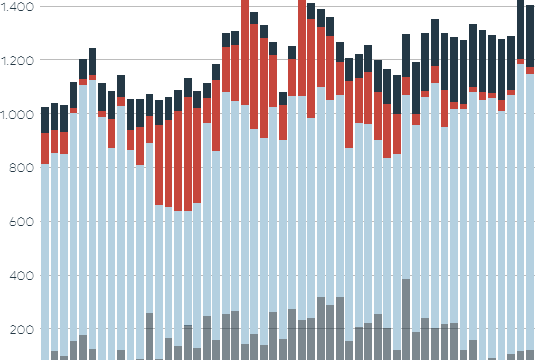June (calendar weeks 23-26) was characterized by an extremely good renewable production of 5,314 GWh (gigawatt hours), which was around 25% higher than the previous year's monthly figure of 4,262 GWh. On balance, Austria was thus able to consistently cover its domestic electricity demand of 4,257 GWh with renewable energy. At 3,999 GWh, hydropower accounted for around 75% of the renewables production in June, which is an increase of 14% in the year-on-year comparison. Even higher growth rates were recorded for wind energy at around 15% (417 GWh) and PV production, which increased by an incredible 153% to 763 GWh.
Surplus of renewable energy leads to a persistent export surge
"The good production from renewable energy sources – also due to the growth rate in the PV sector – enabled us to generate a surplus of electricity in Austria, allowing us to export electricity every day. This continues the trend of Austria being able to export more electricity every month since the beginning of the year than the country had to import. The figures in all areas of renewable production are proof of a very positive momentum with regard to the energy transition. However, from an energy industry perspective the development will only be manageable if we can create an adequately strong electricity infrastructure at the same speed," emphasizes Christoph Schuh, company spokesperson for APG.
No energy transition without a strong electricity grid
A strong grid is necessary to make the volatile, renewable electricity available and to transport it to where it is needed. To avoid grid overloads and ensure a secure supply, the electricity flow is managed with so-called redispatch measures, i.e. the targeted and controlled use of specific power plants.
In June interventions in the schedule of power plants in Austria had to take place on 17 days (in 2023: 16 days) to ensure the security of electricity supply. This causes costs which have to be borne by the electricity customers. In June these costs amounted to approx. 9.9 million euros.
A negative effect in addition to the costs and rising CO2 consumption is the "curtailment" of renewable power plant production: For example, wind power plants or run-of-river power plants that would be producing electricity at a certain time are shut down to avoid overloads in the electricity grid. Since the beginning of the year, an average of around 6,500 MWh of electricity per month has been "lost" due to these measures (the corresponding figure for June was around 1,500 MWh of electricity; the total from January to June was around 39,000 MWh).
"The installed potential output of renewable electricity is of no use to us if the infrastructure required to distribute the electricity is too weak or non-existent. The targeted use of thermal and hydraulic power plants, as well as the curtailment of renewables to prevent grid overload, must be both a warning signal and a wake-up call: without a high-capacity and reliable electricity grid, we will not be able to achieve the energy industry’s goals that are necessary for a secure energy transition and at the same time we will experience increasingly negative economic effects," explains Schuh.
A high-capacity electricity infrastructure, storage facilities, and digital intelligence within the electricity system are necessary to fully capitalize on the planned growth rates of renewables in the coming years. APG's EUR 9 billion investment scheme up to 2034 and its timely implementation is therefore key for achieving the energy transition without jeopardizing the security of supply. The simplification and acceleration of approval procedures are indispensable preconditions in this context.
Energy exchange within Austria
The trans-regional electricity grid of APG facilitates the exchange of energy within the country. Electricity surpluses in individual provinces can thus be distributed throughout Austria to compensate for deficits.
In June the provinces of Upper Austria (433 GWh) and Carinthia (347 GWh) generated the highest energy surplus and made it available throughout Austria via the APG grid. At 389 GWh Vienna had to draw the most electricity from the grid.
Responsible energy consumption
In June (calendar weeks 23-26) 4,257 GWh of electricity were consumed from the public grid in Austria – this is around six percent more than in June 2023 (4,008 GWh).
It is important to act responsibly when it comes to electricity consumption. Saving electricity reduces CO2 and overall systemic costs, which are significant contributions to increasing system security. The trend of reducing CO2 has to be pushed further. This also includes electricity from private PV units.
Tips for saving electricity can be found at www.apg.at/stromspartipps. With the APG Powermonitor, the Austrian population can see the most effective electricity-saving hours and thus make an active contribution to CO2 reduction and system security. The APG Powermonitor can be found at: www.apg.at/powermonitor.
APG continually keeps track of the development of the domestic electricity industry and regularly publishes diagrams at https://www.apg.at/infografiken regarding the topics: energy exchange, energy consumption in Austria, renewables production, import/export, electricity prices, etc.
Click here for the current infographics
About Austrian Power Grid (APG)
As independent transmission system operator Austrian Power Grid (APG) is in charge of ensuring the security of the electricity supply in Austria. With our high-performance and digital electricity infrastructure and the use of state-of-the-art technologies we integrate renewable energies, we are the platform for the electricity market, and we provide access to reasonably priced electricity for Austria’s consumers and thus create the basis for Austria as supply-secure and future-oriented industrial and business location and place to live. The APG grid totals a length of about 3,400 km and is operated, maintained, and continuously adapted to the increasing challenges of the electrification of businesses, industry, and society by a team of approximately 850 specialists. 67 substations are distributed all over Austria and the majority is operated remotely from APG’s control center in Vienna’s 10th district. Thanks to our committed employees Austria had a security of supply of 99.99 percent also in 2023 and thus ranks among the top countries worldwide. Our investments of 445 million euros in 2024 (2023: 490 million euros, 2022: 370 million euros) are a motor for the Austrian economy and a crucial factor in reaching Austria’s climate and energy targets. Until 2034 APG will invest a total of approximately 9 billion euros in grid expansion and renovation projects.
Press contact
Christoph Schuh



